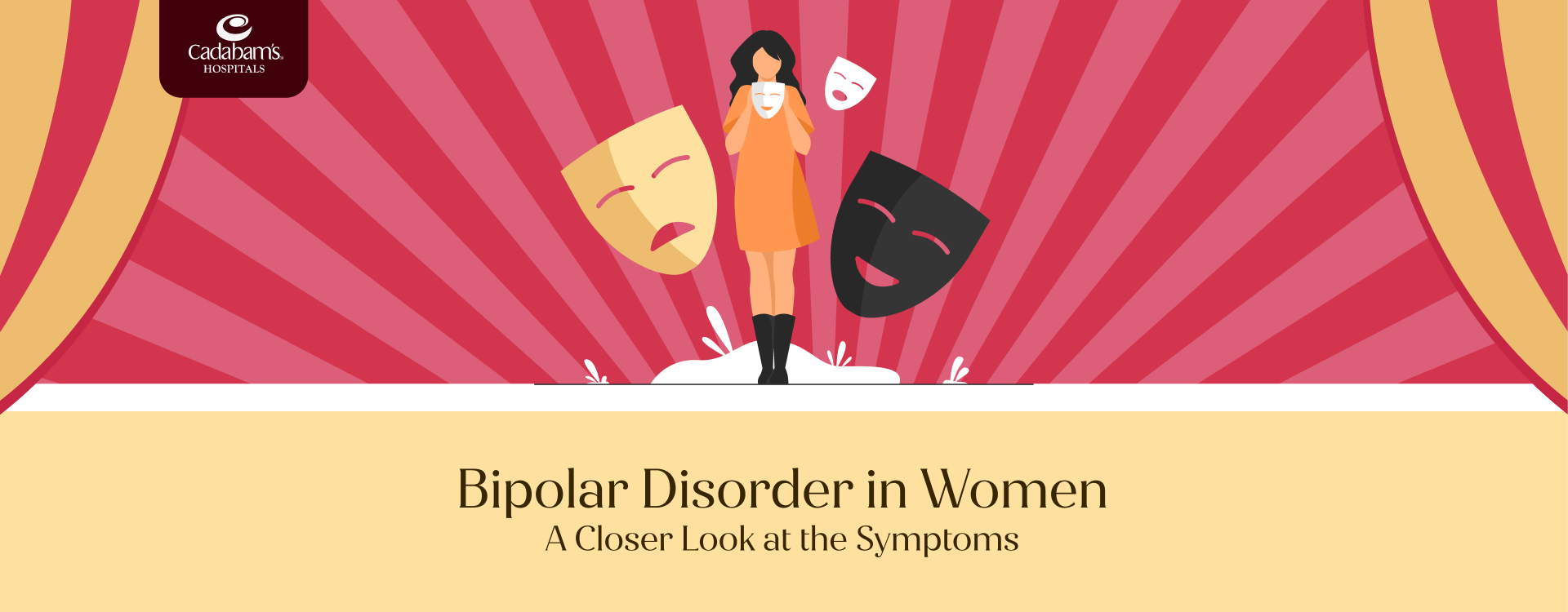Table of Content
Bipolar disorder affects both men and women equally. However, what varies is how the symptoms manifest themselves in the two genders. This article will explore the complexities of this mental health condition and its intersection with women's unique experiences. Understanding these disparities is crucial for tailoring effective diagnosis, treatment plans, and support networks, empowering women to manage their condition and thrive.
An Introduction to Bipolar Disorder in Women
Bipolar Disorder is a mental health condition characterized by extreme mood swings, encompassing periods of intense energy and elation (mania) followed by depressive lows. In women, Bipolar Disorder presents unique challenges, affecting mood, energy, and daily functioning. Hormonal fluctuations, particularly during reproductive phases, can influence the course of the disorder. Recognizing these nuances is crucial for effective diagnosis and tailored treatment approaches.
Key Differences in Bipolar Disorder Between Men and Women
While individual experiences with the disorder may vary, the following differences may be observed in how the disorder presents and progresses in men and women.
Age of Onset
Symptoms typically emerge at around 27 in women, later than the average onset age of 22 in men. Initial presentations in women often involve more frequent depressive episodes, while men commonly exhibit manic episodes first.
Episode Types and Frequency
Men with bipolar disorder often experience full-blown manic episodes and fewer rapid cycling (4 or more episodes per year). In contrast, women are prone to hypomanic and mixed episodes, along with more rapid cycling.
Bipolar Disorder Symptoms in Females
Understanding the nuanced presentation of bipolar symptoms in women is crucial for effective management. Here's a closer look at various symptoms:
The Role of Hypomania and Mixed Episodes
Females frequently experience hypomania, a less intense form of mania, and mixed episodes, blending manic and depressive symptoms. Identifying these conditions is critical for precise diagnosis and implementing tailored interventions to effectively address the unique challenges presented by these nuanced states.
Challenges During Pregnancy and Postpartum Periods
Managing bipolar disorder during pregnancy and postpartum is complex due to hormonal fluctuations. Consultation with healthcare providers is crucial for pregnant women, considering potential impact on mood and energy levels. Medication decisions during pregnancy and breastfeeding require careful discussion, balancing benefits and risks for both mother and baby during this vulnerable postpartum period.
Hormonal Changes and Bipolar Disorder
In bipolar disorder in women, hormonal changes, like those during the menstrual cycle or menopause, can influence mood. Natural shifts in hormone levels may contribute to mood fluctuations, emphasizing the need for close monitoring and collaborative management with healthcare providers to optimize treatment strategies.
Comorbid Conditions
Studies suggest that women with bipolar disorder face an elevated risk of experiencing other mental health and physical conditions along with the disorder. The prevalence of personality disorders, eating disorders, alcohol and substance use problems, thyroid issues, and migraines are common among women with bipolar disorder, emphasizing the need for holistic and tailored healthcare approaches.
Depression Dominance in Bipolar Females
Bipolar disorder in women often presents with more depressive episodes. Women may experience intense feelings of worthlessness, change in appetite, extreme sadness, or suicidal thoughts. Recognizing and addressing this prevalence is essential to effectively manage the challenges associated with depressive episodes and promote overall mental well-being in women with bipolar disorder.
Suicide Risk Among Bipolar Females
Suicide risk is heightened in bipolar females, with one in five succumbing to it, and 20% to 60% attempting suicide at least once. Factors like the presence of a personality disorder, mixed states, limited social support, and a lifelong history of mental health symptoms contribute to increased vulnerability.
Rapid Cycling and Its Prevalence in Females
In women with bipolar disorder, rapid cycling manifests with the swift alternation of at least four manic or depressive episodes within a year. This pattern is referred to as rapid cycling and is associated with elevated risks of depression, suicide, substance abuse, anxiety, and hypothyroidism.
Seasonal Impact
Seasonal variations significantly impact bipolar disorder in women. Depressive episodes tend to peak during autumn and winter, marked by lower energy levels and altered sleep patterns, emphasizing the importance of seasonal considerations in managing bipolar disorder.
Challenges in Women with Bipolar Disorder
In women with bipolar disorder symptoms, challenges emerge due to hormonal fluctuations during menstruation, pregnancy, and menopause which can exacerbate symptoms. Additionally, women are also more prone to comorbid conditions which pose certain challenges for women.
Risk of Misdiagnosis and Delayed Treatment
Misdiagnosis is a common problem for people with bipolar disorder, especially for women who might be mistakenly diagnosed with depression or anxiety instead of bipolar. This delay can lead to inappropriate treatment. Additionally, improper treatment for depression may alleviate some symptoms but could worsen others and trigger manic episodes. Getting the right diagnosis quickly is essential for effective management and a better quality of life.
Overcoming Stigma and Seeking Support
Women with bipolar disorder symptoms face a significant challenge in overcoming societal stigma. Widespread misunderstandings about mental health can make them feel isolated and hesitant to seek help. To break down this stigma, it's crucial to promote open conversations, raise awareness, and build supportive communities. These efforts are essential for empowering women to reach out for the assistance they require, fostering a more understanding and compassionate society.
Balancing Bipolar Disorder with Family and Career Responsibilities
For women managing bipolar disorder, juggling family and work may pose itself to be tricky. The unpredictability of mood swings make it hard to maintain a stable family life and succeed in professional endeavors. Open communications with loved ones, workplace accommodations, and a well-balanced support system are important. It helps women with bipolar disorder manage both family and work responsibilities well, making life smoother.
Treatment Options for Bipolar Disorder in Women
Tailoring approach is required to treat bipolar disorder symptoms in women. It involves a holistic approach, considering medication, therapy, lifestyle changes, and addressing pregnancy or postpartum considerations.
Medication Management
Medications, including mood stabilizers, antipsychotics, and antidepressants, play a crucial role in managing bipolar disorder. However, certain medications may be unsafe during pregnancy or breastfeeding. Discussing these plans with one’s mental health provider beforehand is crucial. The choice of medication depends on the individual's symptoms and needs, with close monitoring to adjust dosages and minimize side effects.
Psychotherapy and Counseling
Therapeutic interventions, such as cognitive-behavioral therapy (CBT) and interpersonal therapy, provide valuable tools for women managing bipolar disorder. Counseling sessions help individuals develop coping strategies, identify triggers, and enhance overall emotional well-being. It provides a safe space to build emotional resilience and reclaim control. At Cadabam’s, our therapy and counseling sessions empower individuals to build coping strategies, identify triggers, and enhance emotional well-being. Explore personalized care with Cadabam’s for a balanced and fulfilling life.
Lifestyle Modifications and Holistic Care
Incorporating lifestyle modifications, such as maintaining a regular sleep schedule, eating healthy, and mindful practices like yoga or meditation can stabilize mood and prevent episodes. Holistic approaches, including mindfulness and complementary therapies, are also recommended. Additionally, joining support groups may foster community and understanding while building healthy relationships and exploring creative outlets boosts emotional well-being.
Addressing Comorbid Conditions
Bipolar disorder is often accompanied by conditions like anxiety and eating disorders, particularly in women. This combination complicates treatment. Addressing these concurrent challenges is integral to comprehensive care. This may require a coordinated effort between healthcare providers to ensure that the treatment plan addresses both bipolar disorder and its associated conditions.
Special Considerations for Pregnancy and Postpartum
Managing bipolar disorder during pregnancy and postpartum requires careful consideration. Collaborative decision-making with healthcare providers is crucial to balance the potential risks and benefits of medications. Monitoring mood changes, establishing a support system, and prompt intervention contribute to a healthier experience for both the mother and the newborn.
Coping Strategies for Bipolar Female
Successfully navigating bipolar disorder requires embracing proactive coping strategies to improve stability and well-being. Consider these key approaches to foster a more balanced and fulfilling life.
Establish a Consistent Routine
Creating and maintaining a consistent daily routine can provide a sense of stability. Regular sleep patterns, meal times, and structured activities contribute to mood regulation, helping to mitigate the unpredictability associated with the symptoms of bipolar disorder.
Stress Management Techniques
Learning and practicing stress management techniques are crucial for individuals with bipolar disorder. Techniques such as mindfulness, deep breathing exercises, journaling, and progressive muscle relaxation can help alleviate stressors, reducing the likelihood of triggering mood episodes.
Build a Strong Support Network
Building a robust support network is paramount. Surrounding oneself with understanding friends, family, and peers creates a safety net during challenging times. Open communication fosters an environment where individuals feel comfortable seeking support and understanding.
Make Healthy Lifestyle Choices
Prioritizing physical health is integral to managing bipolar disorder. Regular exercise, a balanced diet, and sufficient sleep contribute to overall well-being, positively impacting mood stability and energy levels.
Encourage Creative Outlets and Hobbies
Engaging in creative pursuits and hobbies provides a constructive outlet for self-expression and stress relief. Art, writing, music, or other creative endeavors can serve as therapeutic tools, promoting emotional resilience.
Medication Adherence and Management
Consistent adherence to prescribed medications is fundamental in stabilizing mood and preventing relapses. Regular communication with healthcare providers helps to monitor and adjust medication plans based on individual responses and needs.
Seek Professional Counseling and Therapy
Professional counseling and therapy play pivotal roles in managing bipolar disorder. At Cadabam’s, our seasoned psychologists or psychiatrists offer valuable insights, coping strategies, and a safe space for discussing challenges and progress. Regular therapy sessions contribute to ongoing mental health maintenance.
Empowerment in Managing Bipolar Disorder in Females at Cadabams
At Cadabams, we empower women in their journey of managing bipolar disorder. Our comprehensive approach includes tailored therapies, medication management, and holistic strategies. We prioritize creating a supportive environment, fostering resilience and self-advocacy. Through collaborative efforts, we aim to equip women with the tools needed to navigate the challenges of bipolar disorder and lead fulfilling lives.
FAQ
1. What are the signs of bipolar in a woman?
- Extreme mood swings: Rapid shifts between depression and mania (elevated mood, racing thoughts, energy) or hypomania (milder mania)
- Changes in sleep: Insomnia during mania, excessive sleep during depression
- Fluctuations in energy: From boundless energy to exhaustion
- Unusual spending or risky behavior: Impulsive decisions fueled by high moods
- Difficulties concentrating or focusing
- Loss of interest in activities once enjoyed
- Hopelessness, guilt, or suicidal thoughts
2. What are the bipolar symptoms in women?
Bipolar symptoms in women include:
- persistent sadness
- changes in sleep and appetite
- elevated mood and impulsive behavior
- Irritability, difficulty concentrating, and impulsivity
- comorbidities like anxiety and eating disorders
3. What age does bipolar start in females?
Bipolar disorder can emerge in females during adolescence, but the typical onset occurs in the late teens or early twenties. However, it's crucial to note that the age of onset can vary, and some individuals may experience the first symptoms earlier or later in life.
4. Can pregnancy affect bipolar disorder symptoms in women?
Yes, pregnancy has the potential to impact symptoms of bipolar disorder in women. The hormonal changes during pregnancy can influence mood, either worsening or improving bipolar symptoms. It is essential for pregnant women or those planning pregnancy with bipolar disorder to consult healthcare providers.
5. Are women with bipolar disorder more prone to certain comorbid conditions?
Yes, women with bipolar disorder are more susceptible to certain comorbid conditions. Common comorbidities include anxiety disorders, eating disorders, and migraines. The presence of these additional conditions may complicate the management of bipolar disorder in women.
6. What are the treatment options for bipolar disorder in women?
Treatment options for bipolar disorder in women may include a combination of medication, psychotherapy, and lifestyle modifications.
- Medication: Mood stabilizers, antipsychotics, and antidepressants
- Psychotherapy: cognitive-behavioral therapy (CBT) and interpersonal therapy
- Lifestyle Modifications: maintaining a routine, healthy sleep pattern, exercise, and stress management
How Cadabam's Help you for Addiction?
- 410+ Professional Consultants
- 1,00,00+ Happy Faces
- 120+ Currently Seeking Treatments










